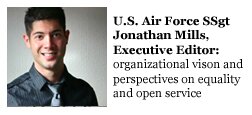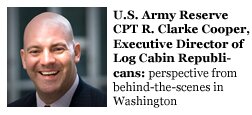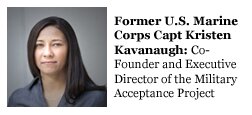By David Small
 I started a new job Monday. Yay! But don’t all cheer at once. During my death by PowerPoint inprocessing, I took particular note of the Equal Employment Opportunity (EEO) briefing.
I started a new job Monday. Yay! But don’t all cheer at once. During my death by PowerPoint inprocessing, I took particular note of the Equal Employment Opportunity (EEO) briefing.
I am a Reservist, so this new job is a civilian government service job under the Department of the Army. I knew there was no addition of the words ‘sexual orientation’ to the military equal opportunity’s (MEO) definition of protected employment for those in uniform once “Don’t Ask, Don’t Tell” was abolished. Baby Steps. But I had no idea that our civilian counterparts’ employment was also not overtly protected based on sexual orientation.
Race, gender… even a relatively new law from 2008 preventing bias based on genetic disposition were all covered. Sexual orientation was glaringly missing.
Googling, I found a vague reference in the Army’s Corp of Engineer’s EEO handbook to sexual orientation being among the various diversities that can exist within a workplace, but it wasn’t referenced anywhere else within the document. Or really on the web from any other Army website I visited.
I also looked up facts of discrimination based on sexual orientation on the Employment Equal Opportunity Commission web page. It states, “The U.S. Equal Employment Opportunity Commission (EEOC) does not enforce the protections that prohibit discrimination and harassment based on sexual orientation.” Whahuh?
I was still pretty sure that sexual orientation is a protected category, just like race, color, religion, sex, national origin, handicap, age and status as a parent, so I went to the Office of Personnel Management’s page and looked up its published facts about addressing sexual orientation discrimination in federal civilian employment. It turns out Executive Order 13087, issued on May 28, 1998, prohibits discrimination based upon sexual orientation within Executive Branch civilian employment. The Executive Order states this policy uniformly by adding sexual orientation to the list of categories.
The president’s Executive Order overtly states, as a matter of federal policy, that a person’s sexual orientation should not be the basis for the denial of a job or a promotion.
So then, why didn’t the Army include sexual orientation in its briefing to me today?
It turns out that cabinet level agencies are responsible for updating their policy statements prohibiting discrimination based on sexual orientation. Some agencies have developed parallel EEO complaint procedures allowing employees to file EEO complaints based on sexual orientation within their agencies. And many agencies have overtly included sexual orientation in their actual statements. But not a single one of the services have done so.
After perusing Army’s EEO page to see if the Army, as a cabinet level, had updated their policy, I finally found the Secretary of the Army’s policy letter. Perhaps sexual orientation falls under ‘other impermissible basis,’ but I’d kind of like to see it spelled out explicitly. I guess they could be working on this… given the Army EEO’s message from the director, mission, vision, org chart, key personnel and strategic plans are all “under construction.” I kind of doubt they are though.
The Air Force basically says the same thing, but at least acknowledges that there may be some random executive order out there they didn’t cover in their list of race, color, etc., etc., when they say “or other executive order.” And the Navy… they don’t even allude to anything outside of the standard list that was derived from the 1960s laws.
I did note, however, some other Department of Defense agencies have overtly stated protections for their employees, such as the Department of Defense Education Activity.
Secretaries of the various Armed Forces Departments: It’s time to review your EEO statements. You have Presidential approval to add sexual orientation as a protected EEO category, and have had such approval since 1998. It should take 14 years to update your EEO statements. And while you’re at it… update your MEO ones too. I’m no JAG, but can’t that executive order cover uniformed people too? They are employees of the executive branch.



























